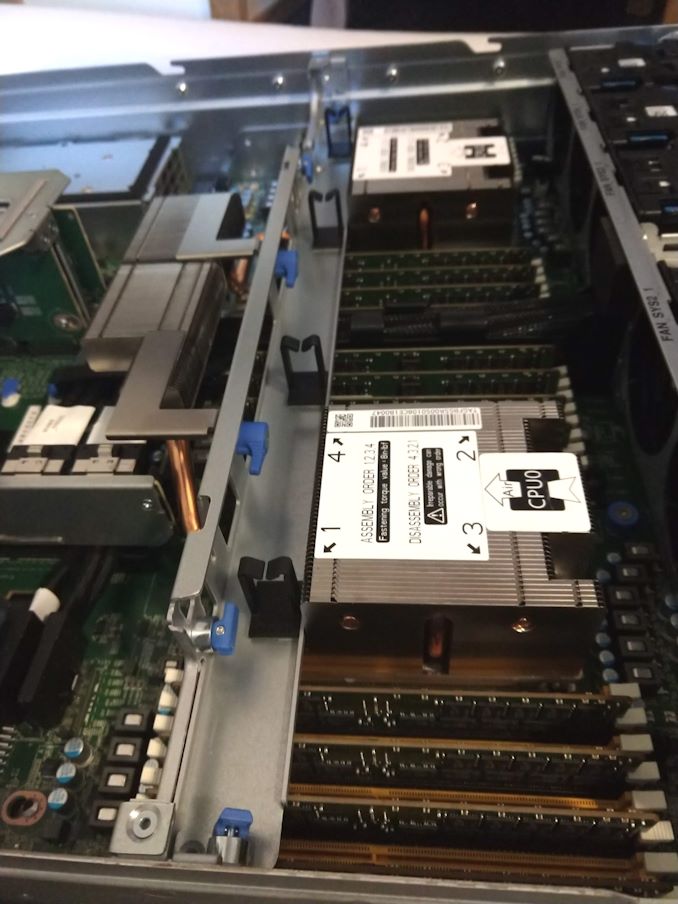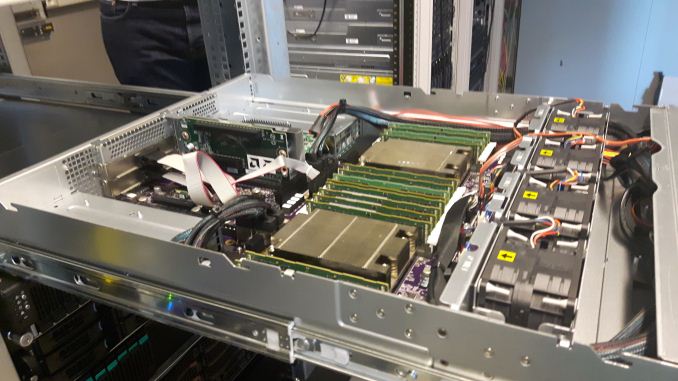AMD Rome Second Generation EPYC Review: 2x 64-core Benchmarked
by Johan De Gelas on August 7, 2019 7:00 PM ESTMurphy's Law
Anything That Can Go Wrong, Will Go Wrong
For those of you that may not know, I am an Academic Director of MCT at Howest University here in Belgium. I perform research in our labs here on big data analytics, virtualization, cloud computing, and server technology in general. We do all the testing here in the lab, and I also do launch article testing for AnandTech.
Undoubtedly, like most academic institutions, we have a summer vacation, where our labs are locked and we are told to get some sunlight. AMD's Rome launch has happened just as our lab closing started, and so I had the Rome server delivered to my home lab instead. The only issue was that our corresponding Intel server was still in the academic lab. Normally this isn't really a problem - even when the lab is open, I issue testing through remote access and process the data that way, in order to reboot the system and run tests and so forth. If a hardware change is needed, I need to be physically there, but usually this isn't a problem.
However, as Murphy's Law would have it, during testing for this review, our Domain Controller also crashed while our labs were closed. We could not reach our older servers any more. This has limited us somewhat in our testing - while I can test this Rome system during normal hours at the home lab (can't really run it overnight, it is a server and therefore loud), I couldn't issue any benchmarks to our Naples / Cascade Lake systems in the lab.
As a result, our only option was to limit ourselves to the benchmarks already done on the EPYC 7601, Skylake, and Cascade Lake machines. Rest assured that we will be back with our usual Big Data/AI and other real world tests once we can get our complete testing infrastructure up and running.
Benchmark Configuration and Methodology
All of our testing was conducted on Ubuntu Server 18.04 LTS, except for the EPYC 7742 server, which was running Ubuntu 19.04. The reason was simple: we were told that 19.04 had validated support for Rome, and with two weeks of testing time, we wanted to complete what was possible. Support (including X2APIC/IOMMU patches to utilize 256 threads) for Rome is available with Linux Kernel 4.19 and later.
You will notice that the DRAM capacity varies among our server configurations. This is of course a result of the fact that Xeons have access to six memory channels while EPYC CPUs have eight channels. As far as we know, all of our tests fit in 128 GB, so DRAM capacity should not have much influence on performance.
AMD Daytona - Dual EPYC 7742
AMD sent us the "Daytona XT" server, a reference platform build by ODM Quanta (D52BQ-2U).
| CPU | AMD EPYC 7742 (2.25 GHz, 64c, 256 MB L3, 225W) |
| RAM | 512 GB (16x32 GB) Micron DDR4-3200 |
| Internal Disks | SAMSUNG MZ7LM240 (bootdisk) Micron 9300 3.84 TB (data) |
| Motherboard | Daytona reference board: S5BQ |
| PSU | PWS-1200 |
Although the 225W TDP CPUs needs extra heatspipes and heatsinks, there are still running on air cooling...
AMD EPYC 7601 – (2U Chassis)
| CPU | Two EPYC 7601 (2.2 GHz, 32c, 8x8MB L3, 180W) |
| RAM | 512 GB (16x32 GB) Samsung DDR4-2666 @2400 |
| Internal Disks | SAMSUNG MZ7LM240 (bootdisk) Intel SSD3710 800 GB (data) |
| Motherboard | AMD Speedway |
| PSU | 1100W PSU (80+ Platinum) |
Intel's Xeon "Purley" Server – S2P2SY3Q (2U Chassis)
| CPU | Two Intel Xeon Platinum 8280 (2.7 GHz, 28c, 38.5MB L3, 205W) Two Intel Xeon Platinum 8176 (2.1 GHz, 28c, 38.5MB L3, 165W) |
| RAM | 384 GB (12x32 GB) Hynix DDR4-2666 |
| Internal Disks | SAMSUNG MZ7LM240 (bootdisk) Micron 9300 3.84 TB (data) |
| Motherboard | Intel S2600WF (Wolf Pass baseboard) |
| Chipset | Intel Wellsburg B0 |
| PSU | 1100W PSU (80+ Platinum) |
We enabled hyper-threading and Intel virtualization acceleration.












180 Comments
View All Comments
ET - Thursday, August 8, 2019 - link
I found the EPYC 7262 the most interesting SKU. By L3 cache size, that would be 4 chiplets, each offering only 2 cores. From the specs it looks like AMD has no shortage of 4 core chiplets, but I didn't expect 2 core chiplets.Rudde - Friday, August 9, 2019 - link
L3 cache is shared inside a CCX (4 cores), which suggests that every CCX has only one core available, but 16MB of L3 cache. I.e. every core has private L3 cache.colonelclaw - Thursday, August 8, 2019 - link
But can it serve Crysis Battle Royale?shing3232 - Thursday, August 8, 2019 - link
I am pretty sure it can lolBigMamaInHouse - Thursday, August 8, 2019 - link
@ Johan De Gelas will u test @240W TDP config?JohanAnandtech - Thursday, August 8, 2019 - link
Elaborate your interest in that, as it is only tad higher than the official 225W TDP?BigMamaInHouse - Thursday, August 8, 2019 - link
AMD is offering 225W/240W TDP option in bios to it's customers and lets them to decide if to go with better cooling and use 240W or stay at 225W, even though it looks small increase- in reality it should offer almost 10% more power headroom to the CPU chiplets -if you consider that the 225W is including ~55W for I/O die, so extra 15W for the chiplets alone should offer nice bump in clocks.Gondalf - Thursday, August 8, 2019 - link
Strange.....the article forgot Cooper Lake, out in Q4 this year and at major customers (for revenue) from at least two quarters. Same applies to Ice Lake SP that is in evaluation to OEMs right now.From the article looks like Intel is sleeping, but it is not at all. Ummm maybe Intel is snobbing some guys here not giving samples to test?? or informations to share??
Bet Intel have to argue about the test suite or about compiler settings.........
JohanAnandtech - Thursday, August 8, 2019 - link
Because Cooper Lake is still "warmed up Skylake" (unless I missed something). AFAIK it is Cascade Lake with 8 mem channels - so the 56-core socketed will probably be still in the 350-400W TDP range. So the SPEC benchmarks will look better, but getting that kind of server running inside your datacenter does not look very attractive: complex and thus expensive boards, high cooling and power distribution required. Looks like a chip that wins back benchmarks, but is too much hassle to roll out in high quantities.Null666666 - Friday, August 9, 2019 - link
Wondering when 4-8 socket ice lake is due.